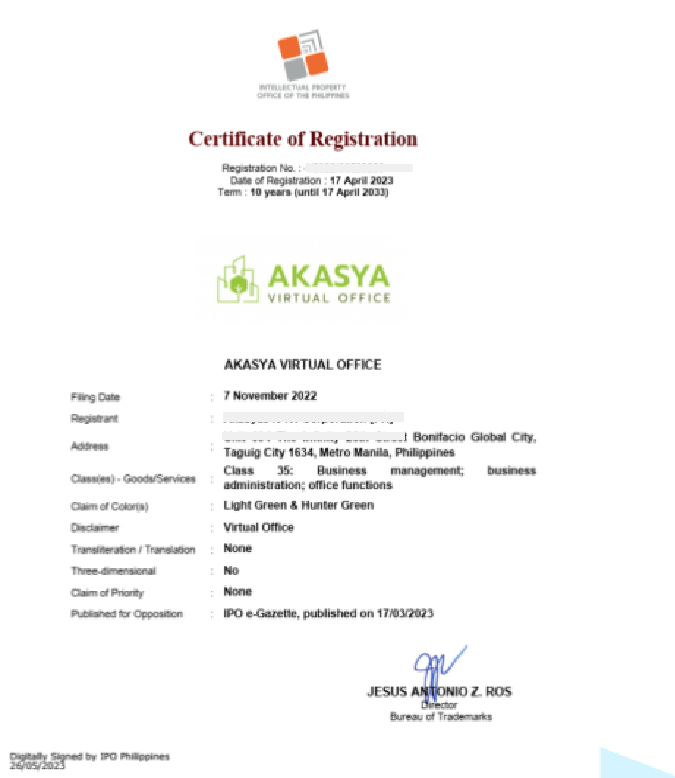As the Philippines steadily advances its economy and digital landscape, understanding intellectual property (IP) rights has become increasingly vital, particularly for artists and entrepreneurs. Fortunately, there is already a robust legal framework that protects creative endeavors and fosters growth.
Among the various forms of intellectual property rights — like copyrights and patents — trademarks have recently gained significant interest due to their critical role in branding and distinguishing products and services in the market.
Without having duly registered a trademark, there is a high risk of leaving a brand vulnerable to public confusion and imitation, hence diluting the hard-earned reputation. By investing in trademark registration, you’re not just protecting your business name or logo — you’re also fortifying your unique brand identity and securing your position in the market. In essence, a trademark is a shield that safeguards your brand’s identity and the key that opens the door for its future growth.
In this article, we’ll comprehensively discuss trademark registration in the Philippines, focusing on the requirements, processes, fees, and everything you need to know. Read on and tell us in the comments how we can assist you. You might also be interested in our Comprehensive Trademark Registration Service.
Trademark
First, what is a trademark? As defined in the Intellectual Property Code (IP Code) of the Philippines, a “mark” is any visible sign capable of distinguishing the goods (trademark) or services (service mark) of an enterprise and shall include a stamped or naked container of goods. “Trade name,” on the other hand, means the name or designation identifying or distinguishing an enterprise (Section 121).
“Collective mark” means any visible sign designated as such in the application for registration and capable of distinguishing the origin or any other common characteristic, including the quality of goods or services of different enterprises which use the sign under the control of the registered owner of the collective mark (Section 121).
Registrable and Non-Registrable Marks
In the Philippines, the types of marks that can be registered as trademarks include the following:
- Word Mark. A word mark is represented using words, letters, numbers, or any other characters that can be typed.
- Figurative Mark. A figurative mark is represented using pictures, graphics, or images. It does not contain words or letters.
- Figurative with Words Mark. A figurative mark containing word elements combines the use of pictures, graphics, or images with words or letters.
- 3D Mark. A three-dimensional or 3D mark is represented using a three-dimensional shape, such as the actual product or its packaging.
- Stamped or Marked Container of Goods. A stamped or marked container of goods is any container of goods on which a mark is impressed or molded. The representation should be a single JPEG file of an image, sketch, or photo.
Non-registrable marks or those that cannot be registered with IPOPHL, on the other hand, include immoral, deceptive, or scandalous matters; flag, coat, or other insignia of the Philippines; names, signatures, or portraits of living individuals without their consent; confusingly similar to previously registered or applied marks; confusingly similar to well-known marks; misleading and deceptive marks; generic marks; customary marks; shapes; colors; and marks contrary to public order or morality.
Intellectual Property Office of the Philippines (IPOPHL)
Trademarks, trade names, service marks and names, or other marks of ownership are applied for registration and registered with the Intellectual Property Office of the Philippines (IPOPHL or IPO). It is the government agency mandated to administer and implement state policies on intellectual property (IP).
The IPOPHL now allows online filing of trademark applications through its eTMfile website facility. eTMfile is open 24/7 (except for scheduled maintenance), and it is linked to two other tools — ASEAN TMclass and ASEAN TMview — which allow easy classification of goods and services and generation of preliminary search reports.
Intellectual Property Code (IP Code)
Trademark registration in the Philippines is governed primarily by Republic Act 8293 of 1997, also known as the “Intellectual Property Code of the Philippines,” as amended.
The law consolidated and repealed other individually pre-existing laws on patents, trademarks, and copyrights (i.e., R.A. 165, R.A. 166, P.D. 49, and P.D. 285, among others). It prescribes the code for various intellectual properties – patents, utility models, industrial designs, trademarks, service marks, trade names, copyrights, original works, and derivative works – and sets the corresponding rules and regulations.
Nice Classification System
The IPOPHL follows the International Classification of Goods and Services for the Purposes of the Registration of Marks, also known as Nice Classification (NCL) after having been established by an agreement concluded at the Nice Diplomatic Conference on June 15, 1957.
The Nice Classification is based on the classification prepared by the United International Bureaux for the Protection of Intellectual Property (BIRPI) – predecessor of WIPO – in 1935. It was that classification, consisting of an initial list of 34 classes and an alphabetical list of goods, that was adopted under the Nice Agreement and later expanded to embrace also 11 classes covering services and an alphabetical list of those services. Since 2013 (NCL10), the classification is revised once a year, and a new version of each edition is published annually.
Benefits of Trademark Registration
Although not mandatory, trademark registration is highly recommended for a number of reasons and benefits:
Exclusive Intellectual Property Rights
Once a trademark is registered with IPOPHL, the owner is granted exclusive rights to use, license, or sell the mark. Only the registered owner can legally use the mark within the scope of the business activities.
Legal Protection
The exclusive rights granted to the trademark owner come with legal protections. That means the owner may take legal action or sue infringers for damages against the use of the trademark without permission.
Deterrence Against Infringement
After having been accepted by IPOPHL, the trademark may already be used with the ‘registered trademark’ symbol, which also serves as a public notice of the claim of the mark and deters others from using it.
Enhanced Brand Recognition
A registered trademark is a crucial component of brand identity that sets products and services apart and fosters consumer trust and loyalty. Undeniably, consumers patronize more reputable and well-protected brands.
Asset Value
Like other intellectual properties, a trademark is also an asset in which the value may increase over time as the overall value of the brand increases. It may then be bought, sold, or licensed.
Trademark Registration Requirements
As mentioned, trademark applications may already be filed online with IPOPHL through its official website (eTMfile). Forms and documentary requirements may also be accomplished online and uploaded.
Sample Mark
A reproduction of the mark in a required format and size must be uploaded to the website. Selecting the appropriate Nice Classification is part of the application process. There are websites, such as TM Class, WIPO Madrid, and UPSTO that can be checked for the classes of goods and services.
Trademark Information
Specific details about the mark, such as the title, claim of colors, translation, disclaimer, type, etc., must be provided after uploading a copy and accomplishing online forms.
Applicant’s Information
Applicant’s personal or business information (i.e., either natural or juridical person), such as the complete name, address, contact numbers, email address, and nationality, must also be provided.
Resident Agent and Authorization Documents
Non-resident foreign applicants must have a resident representative to receive notices and to attend to proceedings involving the mark. Equally, if the application is filed by a representative or on behalf of a legal entity, e.g., a company, additional legal documents, such as special power of attorney (SPA), board resolution, and secretary’s certificate are normally required.
Trademark Registration Process in the Philippines
Before you process your trademark registration, make sure that you have gained enough understanding of the basics of the IP Code, the grounds for refusal, and all documentary requirements.
1. Online Submission of Application
To submit the application for trademark registration, access the eTMfile facility on the official website of IPOPHL. Select the appropriate mark (e.g., figurative mark), upload the sample, and complete the details.
There are five (5) stages for the submission – trademark, goods and services, priorities, applicant’s details, and confirmation. Once all of these are accomplished, the application will be examined for registrability in the order in which the complete requirements for grant of a “filing date” are received.
You may also opt for a priority examination; however, this is subject to a petition under oath, payment of additional fees, and approval of the assigned examiner.
2. Examination of Application
Your application will then be assigned to a trademark examiner, an official or employee of the Bureau of Trademarks authorized to examine trademark registrations and renewals.
If your trademark is found non-registrable for any reason, you will be advised of the reasons through a Registrability Report and required to respond or make certain actions within two (2) months from the mailing date. If there is no issue, however, a Notice of Allowance will be received. You may then proceed to the payment of fees.
3. Publication in the IPOPHL eGazette
After your payment, your trademark application will be published in the IPOPHL eGazette and subject to public opposition for thirty (30) days.
Any third party may oppose the application and make the necessary legal filings with the agency. Grounds for opposition usually include lack of distinctiveness, confusing similarity, bad faith application, and misrepresentation of ownership.
4. Issuance of Certificate of Registration
When no opposition is filed within the period after the publication, the mark is deemed registered on the next calendar day. You will then be issued a Certificate of Registration which will certify your exclusive rights over the registered trademark for the next ten (10) years.
Trademark Registration Fees
Trademark registration fees vary depending on many factors, such as the size of the registering entity, number of marks and classes, examinations, and appeals.
Based on the Schedule of Trademark-Related Fees published on the website of IPOPHL, here are the general fees for small and big entities:
| Fees | Small Entities | Big Entities |
| Filing Fee (per class) | PHP 1,200.00 | PHP 2,592.00 |
| Claim for Convention Priority (per class) | PHP 860.00 | PHP 1, 800.00 |
| Claim of Color, Claim of Distinctiveness (per class) | PHP 280.00 | PHP 600.00 |
| Request for Priority Examination | PHP 2,990.00 | PHP 6,240.00 |
| Issuance of Certificate of registration (COR) | PHP 570.00 | PHP 1,200.00 |
| Publication of Registration (2nd Publication) | PHP 900.00 | PHP 960.00 |
| Correction (Without Fault of Office) | PHP 570.00 | PHP 1,200.00 |
| Voluntary Cancellation | PHP 280.00 | PHP 600.00 |
| Voluntary Disclaimer | PHP 280.00 | PHP 600.00 |
| Division of Registration | PHP 570.00 | PHP 1,200.00 |
Fees indicated above are for instant reference purposes only. These may change without prior notice. Always check the official website of IPOPHL or contact the agency.

Common Trademark Registration Mistakes and Tips
When processing trademark registrations, mistakes lead to delays, rejections, complications, or even waste of resources. Here are the most common pitfalls to avoid:
Insufficient Knowledge
For many, registering a trademark is simply about claiming ownership over a word or a figurative mark. By reading the IP Code, however, you will know how broad trademark registration is. The law clearly identifies those marks that cannot be registered. For instance, registering a mark that is too generic or distinctive can result in rejection.
Inadequate Trademark Search
Although there is an assigned examiner who will look closely into the application, it is extremely important to conduct a thorough research for existing trademarks first to avoid conflicts with those already registered or with pending registration. Use available databases for the search or seek professional assistance.
Incorrect Trademark Classification
Misclassifying the goods or services associated with the trademark can lead to rejection, issuance of a Registrability Report, or delay in the processing of the application. While there are various resources available online for Nice Classification, it is still best to consult a trademark specialist for precision.
Unclear or Incomplete Representation
Submitting an unclear or incorrect representation or sample of a trademark can lead to issues during examination. Before filing the application, make sure to research and read IPOPHL’s requirements, the IP Code, and other helpful guides.
Ignoring Registrability Reports and Office Actions
Failing to respond to office actions or the examiner’s requests for additional information within the given period often leads to abandonment or cancellation of the application. To avoid this, prompt address all IPOPHL communications. Seek also professional assistance, especially if legal expertise is needed.
Expert, Fast, and Compliant
We can provide full assistance in registering your company logo and trademarks with IPOPHL, securing your exclusive brand ownership and protection.
Trademark Registration FAQs
Here are some frequently asked questions and answers about trademark registration to help clarify common concerns and provide a summary of the foregoing discussion:
1. Is Trademark Registration Mandatory in the Philippines?
In the Philippines, trademark registration is not mandatory, however highly recommended for businesses and individuals seeking to protect their brand identities.
2. Who Can Apply for Trademark Registration?
Local and foreign natural persons and legal entities may file for trademark registration. Non-resident foreign applicants, however, must have a resident representative, i.e., to receive notices and attend proceedings, if any.
3. Is It Possible for a Single Trademark to Have Multiple Owners?
Yes. Joint ownership of a trademark is possible and allowed, where two or more individuals or entities have ownership claims.
4. Should I Register My Trademark Immediately?
Yes, it is highly recommended because of the first-to-file rule, which means that those who are first in time shall be first in right. As such, you can exclusively benefit and exploit your trademark at the earliest possible time.
5. What is a Priority Examination?
Like an express service, a priority examination is an option for the applicant to request for the application to be processed first in certain circumstances, however subject to additional requirements and fees.
6. Is Prior Commercial Use of the Trademark Required?
No. Prior commercial use is not required at the time of filing of the trademark application.
7. Can I Register a Single Trademark for Multiple Classes?
Yes. One trademark application may cover several classes to relate to several classes of goods and services under the Nice Classification. However, this will only result in one trademark registration.
8. Is a Divisional Trademark Application Allowed?
Yes. A multi-class trademark application may also be divided into several trademark applications, called divisional applications. The divisional applications shall preserve the filing date of the initial trademark application or the benefit of the right of priority.
9. What is a Registrability Report?
A Registrability Report is the first Office Action (OA) that contains the findings of the examiner concerning non-compliance or issues with the mark based on the examination of the application in accordance with the IP Code and other regulations.
10. What are the Remedies in Case of Final Rejection of Trademark Application?
Trademark applicants may file for a Notice of Appeal within two (2) months from the mailing date of the Final Rejection Notice and file an Applicant-Appellant’s Brief within two (2) months from the date of filing of the Notice of Appeal.
11. How Long Does Trademark Registration Take?
Trademark registration in the Philippines usually takes six (6) months to one (1) year, but may also take longer, especially if there is a need for appeals or additional documentary requirements.
12. When is a Trademark Registration Considered Abandoned?
According to Rule 610 of the IPOPHL Memorandum, if the applicant does not respond or submit a complete response within the given period from the mailing date of the examiner’s action, the application will be considered abandoned on the day following the last day of that period.
13. How Can an Abandoned Application Be Revived?
An abandoned application may be revived within three (3) months from the mailing date of the notice depending on the satisfaction of the examiner. A request must be accompanied by a statement of the causes of delay in submitting the complete response.
14. What is the Validity of Trademark Registration?
The trademark registration is valid for ten (10) years with declaration of actual use or non-use after three (3) and five (5) years of registration. Requests for renewal must also be filed before the 10th year registration anniversary with six (6) months grace period. The Renewal Declaration of Actual Use may be filed within the six (6)-month period before the expiration of registration.
15. What is a Declaration of Actual Use (DAU)?
A Declaration of Actual Use, or DAU, is a notarized sworn statement that states about the actual use of a trademark for identified goods and services in the Philippines.
Why You Need Professional Assistance in Trademark Registration
Although the trademark registration process seems straightforward as discussed, there are many other factors that affect the processing timelines and final approvals. Trademark specialists can help you navigate through the various legal and technical requirements, prepare necessary documentations, and streamline the process.
Initially, they can provide you with practical advice on your marks, as they know very well the provisions of the IP Code, particularly on the absolute and relative grounds for the refusal of trademark registration. During the application process, they can also help resolve various issues through formal communications with the IPOPHL. Lastly, they can walk you through the necessary steps to keep the trademark legally protected.
… and you might just need our assistance.
We, at FilePino, a one-stop-shop business consulting firm trusted by thousands of clients for their business formation and post-formation needs, offer a comprehensive trademark registration service in the Philippines.
With our sister company, Duran & Duran-Schulze Law, we guarantee that there will be an in-house team of lawyers and trademark specialists, who can provide you with accurate information and complete guidance throughout the trademark registration process.
Ready to register your trademark? Set up a consultation with FilePino today! Call us at (02) 8478-5826 (landline) and 0917 892 2337 (mobile) or send an email to info@filepino.com.










4 Responses
I want to register a name brand for a future business with 2 class services. Please send quotation.
Hi Juan! Kindly call us at (02) 8478-5826 (landline) and 0917 892 2337 (mobile) or send an email to info@filepino.com. We’re here to assist you with your trademark registration.
Can I request for a quotation of registration of new trademark, what are the process in requirements?
Hi Jasper! Thanks for your interest in our trademark registration service. We’ll be sending you an email shortly with the service fee details and the necessary documentation. If you need immediate assistance, feel free to call us at (02) 8478-5826 (landline) or 0917 892 2337 (mobile), or email us at info@filepino.com.